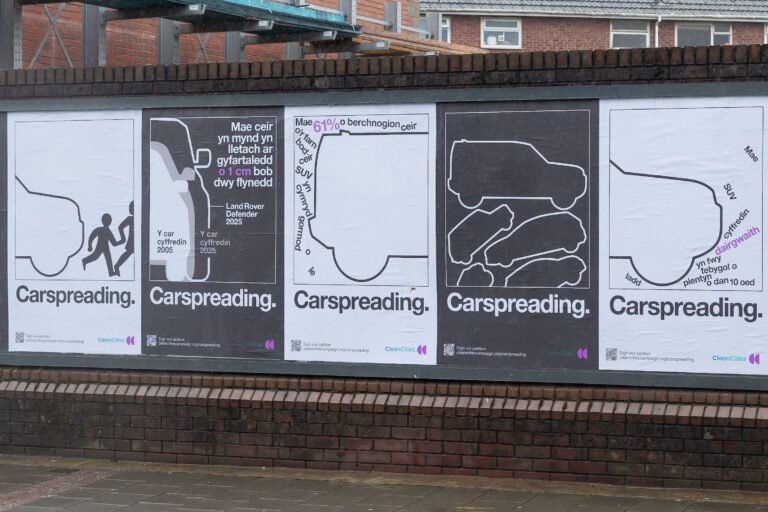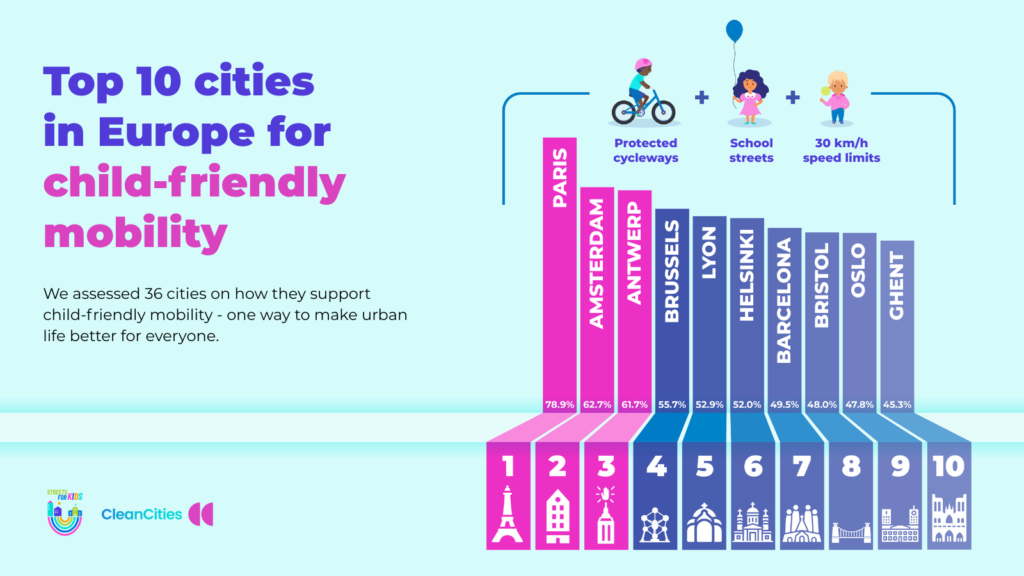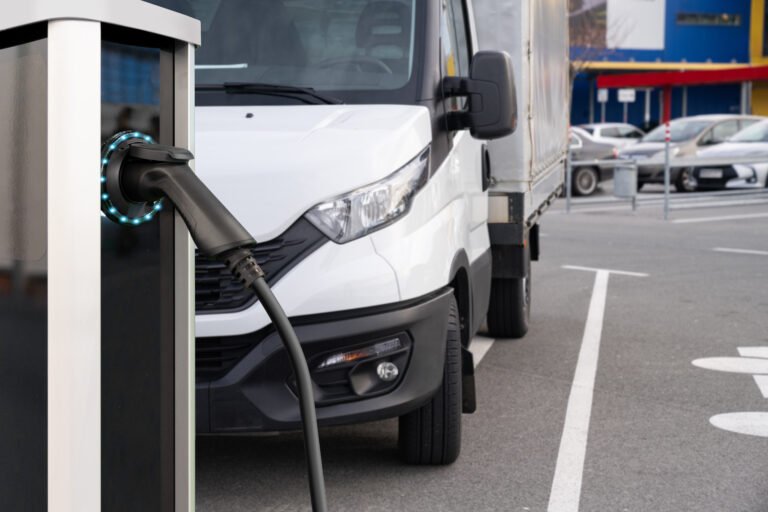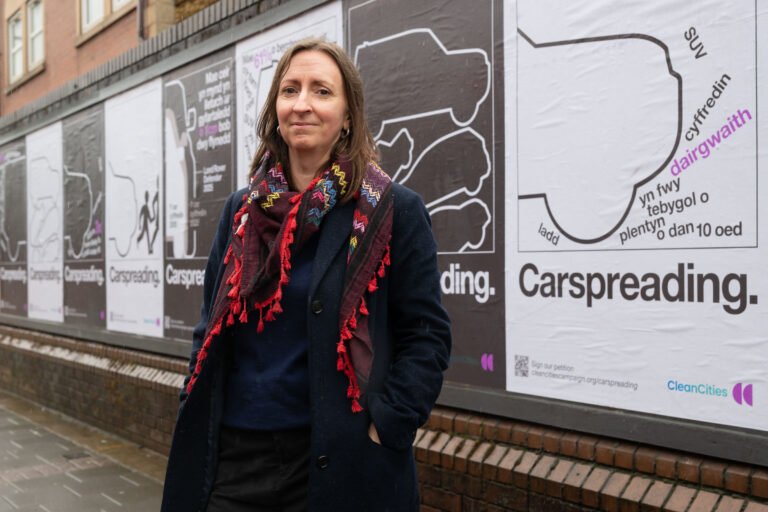
Europe’s best cities for child-friendly mobility ranked - with surprise winner
Rapid progress by Paris, London and Brussels challenges traditional leaders like Amsterdam and Copenhagen.
Paris has made dramatic progress to become Europe’s best city for children to walk, cycle and get around independently, according to a detailed ranking published today.
The City of Light topped a table of 36 European cities thanks to its extensive but relatively new network of protected bicycle lanes, reduced speed limits and low or no traffic zones near schools.
Amsterdam, Antwerp, Brussels, Lyon and Helsinki come next in the ranking; a mix of long-standing pioneers in progressive urban mobility and rapidly improving newcomers.

The ranking is based on official data [1] collected by the international non-profit Clean Cities Campaign. The group benchmarked cities on three indicators that closely reflect United Nations and other expert advice for making cities and mobility more friendly to children, who are especially vulnerable [2].
The first benchmark is the number of school streets at primary schools, which regulate traffic to boost road safety, limit noise and improve air quality, as well as walking and cycling rates of children. London has 525 near primary schools, far more than any other city in the ranking [3]. Milan and Paris are runners up.
Studies show that children feel safer in cycle lanes that are physically separated from traffic, the second benchmark. Paris and Helsinki both enjoy a protected cycling network extending nearly half (48%) as long as their road networks, more than any other city in the ranking [4]. Copenhagen comes next with 43%.
The third benchmark is urban speed limits of 30 km/h, which reduce pollution and crashes, a “no regret” option supported by the WHO, OECD and European Transport Safety Council. Paris limits speed on nearly all its road length (89%), more than any other city in the ranking [5], followed by Brussels and Lyon.
“Children are less free to get around town and less active than they once were, especially girls. But our ranking shows that parents, teachers and city administrations can make huge and rapid progress.
“Taking a walk through Paris today is a breath of fresh air compared to 10 years ago. It takes vision, leadership and sustained investment, but most cities can and should make similar progress.”
Barbara Stoll, Senior Director, Clean Cities Campaign
Secrets to success
Long-standing pioneers in progressive urban mobility, such as Amsterdam (2nd place overall, B grade) and Copenhagen (11th, C), remain near the top of the table, while Paris, Brussels (4th, C) and London (14th, C) have made rapid recent progress to win their high ranks.
Both new and old champions often owe their success to committed city leaders, Clean Cities found, a factor that can disrupt otherwise clear performance divides between North and South of Europe, West and East and between income levels. National policy is less decisive, with cities in the same country gaining very different ranks. Italy’s best performer Bologna (16th, C) contrasts with Florence (29th, E) and Rome (32nd, E), while in Spain, Barcelona (7th, C) contrasts with Madrid (26th, D) and Zaragoza (28th, D).
Uneven progress
There is a general trend of cities earning high marks for lowering speed limits and losing them for having few or no school streets – a factor that explains why no city scored an A grade.
Paris came close, performing well on all three indicators, but still needs to roll out more school streets. At the bottom of the ranking, with grades of E and F, are a host of Southern, Central and Eastern European cities for various reasons.
Italy is a leader for its high quality pedestrianised school streets, but overall, it has no cities ranked in the top ten and four at the bottom of the table, owing to a lack of sustained political leadership and investment, plus resistance when progressive measures were tried, such as in Bologna.
Germany and Poland have no cities in the top ten, owing to a persistent car culture and cities lacking complete control of speed limits and parking. Despite this, strong leadership has helped Munich (12th, C) and Wroclaw (20th, D) climb the ranking.
Ten cities have no school streets and most of those that do exist across Europe are only in force during child drop-off and pick-up times, rather than pedestrianised. Vehicles can still drive dangerously fast in five cities, where less than 10% of streets have a 30km/h speed limit, while protected cycle lanes are relatively rare across the 36 cities, covering the equivalent of only 17% of city roads on average.
Clean Cities is calling on all cities to adopt a child-first approach to urban mobility. Governments should empower cities where necessary, the group said, while the European Commission should better promote school streets and protected cycle lanes in upcoming legal guidance and improve data collection rules.
Notes to Editors:
- Clean Cities communications consultant: Jack Hunter (EN) jack@fthe.fr +33 (0)7 54 54 35 48 (WA, Signal)
- Clean Cities press team: media@cleancitiescampaign.org +44 (0)79 74 33 23 29
- [1] Clean Cities spent 5 months gathering data directly from administrations and other public sources. The 36 cities chosen represent a cross-section of geographical locations, urban sizes, and approaches to mobility.
- [2] Children’s developing bodies and behaviours, including higher rates of walking and cycling than adults, put them at greater risk from road accidents and pollution. One child is killed each day in the EU on average, while around eighteen are seriously injured in road collisions daily, though accident rates vary widely across Europe. Over a thousand children and teenagers are estimated to die prematurely from air pollution in Europe each year. The rise in car ownership has been linked to a fall, sometimes dramatic, in children’s ability to travel independently, especially girls, contributing to an “epidemic” of inactivity.
- [3] Nearly 1,000 school streets now exist in 26 of the cities surveyed. At least a fifth of primary schools have them in London, Milan, Paris, Turin and Antwerp. School streets enjoy strong support and are more common in cities where parents, pupils and teachers have campaigned for them.
- [4] After Paris and Helsinki, other cities with high rates of safe bike lanes are Copenhagen, Munich, Amsterdam, Hamburg, followed by Antwerp. Barcelona and Wrocław are catching up.
- [5] Cities with over 80% coverage of 30km/h speed limits are Paris, Brussels, Lyon, Amsterdam, Bristol and Madrid.

